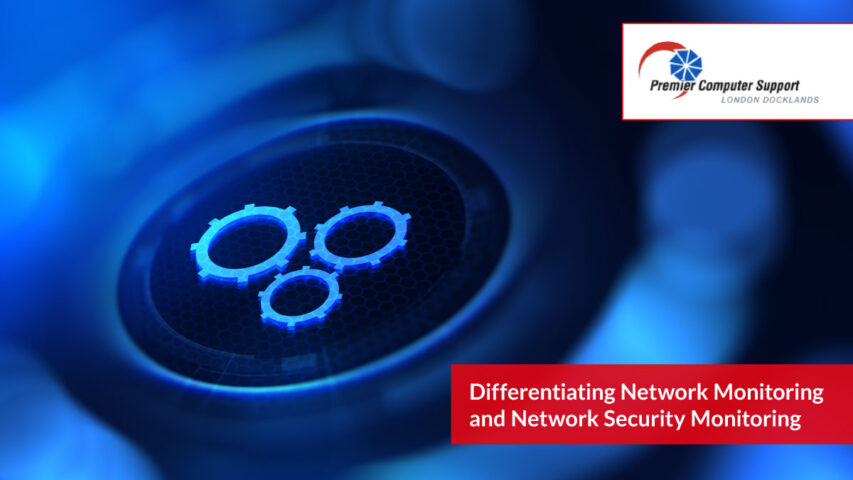- Providing the service others only promise
- +44 (0) 020 7345 5139
Differentiating Network Monitoring and Network Security Monitoring
Differentiating Network Monitoring and Network Security Monitoring
As technology advances and organisational networks expand, administrators are given more and more responsibility for the infrastructure’s overall health and performance. Chief information officers are always assessing how to efficiently monitor and secure activity on their organisation’s network.
You may encounter network monitoring and network security monitoring and get confused about their functions. The sections below will give you a clear overview of each task and its contribution to your company.
1. Network Monitoring
A network monitoring system tracks network activity and keeps a look out for any malfunctions or issues caused by malfunctioning equipment or overtaxed resources like servers, network connections, or other devices.
Standard network monitoring is commonly performed from a command-line interface using any of the many easily available tools as well as with the assistance of diagnostic tools, specialist programmes, or appliances linked to the network.
It monitors three crucial metrics like configuration, performance, and availability and sets a baseline for data-at-rest using measurements and algorithms.
A network administrator who is familiar with the system’s topology, settings, performance, and security must manage and oversee various aspects of each of the three metrics.
When an issue is discovered, an alert is sent to the administrator via e-mail, SMS, and other messaging methods so that they may take the necessary action.
A Broad View of the Infrastructure
Many elements of more straightforward cloud-hosted infrastructure solutions for small businesses are occasionally acceptable. Without fully understanding the underlying technology, the administrator would just need to supervise and manage the services that are hosted in data centres.
But a business comprises many intricate parts, including cloud infrastructure, that frequently span several locations and use different kinds of technology.
A corporation needs additional help with network monitoring to maintain complex subnetting and configurations across several switches, routers, servers, and load balancers that serve thousands of users.
A more important component of your architecture might be the acquisition of monitoring tools that provide administrators access to real-time statistics and visibility into the underlying network. With more systems, appliances, and other components connected to your network, the risk of a critical, disruptive hardware failure rises.
A more sophisticated, continuous real-time monitoring system warns you before the issue emerges, giving administrators the chance to address it before it has an impact on your company’s bottom line.
The majority of monitoring systems notify you when a breakdown or issue occurs within the network.
2. Network Security Monitoring
While network monitoring delivers data collection for analysis of basic traffic flows, the overall structure, and the integrity of your systems, network security monitoring shields you from the numerous potential vulnerabilities and attacks in the wild.
Since it evaluates a variety of intricate factors such as network payload, network protocols, client-server relationships, encrypted traffic sessions, traffic patterns, and traffic flow, security monitoring is equally as important as general monitoring.
Informing administrators of known harmful activities is done in an effort to contain a threat. With the right monitoring technology, you get 24-hour service that keeps an eye out for workplace dangers and questionable behaviour.
Administrators and analysts can then investigate and assess odd user patterns and take the appropriate action.
Surveillance and Action against Intruders
As opposed to operational network monitoring, network security monitoring requires analysts to be able to detect intrusions and all forms of assaults, including new, zero-day, and cutting-edge threats.
New continuous network monitoring and analysis tools, which provide varying degrees of detection and mitigation assistance, can greatly lower the likelihood of an attack or breach. Despite this, no security expert can guarantee total defence from threats.
Additional help for those who can benefit from continuous real-time network security monitoring, analysis, and restoration include a decrease in detection time and the ability to mitigate or avoid the ensuing damage drastically.
The fact that a hacker can compromise and steal data in just a few minutes must be emphasised.
Thus, two measures of the efficiency of a network security monitoring system are the speed at which suspect traffic is registered to administrators and whether the system continually monitors data-in-motion or data-at-rest.
Conclusion – Differentiating Network Monitoring and Network Security Monitoring
Although the distinction between network monitoring and network security monitoring may be blurring, each function has a very specific and crucial role to play inside an organisation.
Despite the fact that their tools can be used in tandem, they each focus on distinct and varied aspects of network traffic and infrastructure.
If you need first-rate IT support for businesses, don’t hesitate to choose Premier Computer Support Ltd! We’re an IT solutions company, specialising in providing IT Support and related IT Services with a large client base within London and the surrounding counties.

